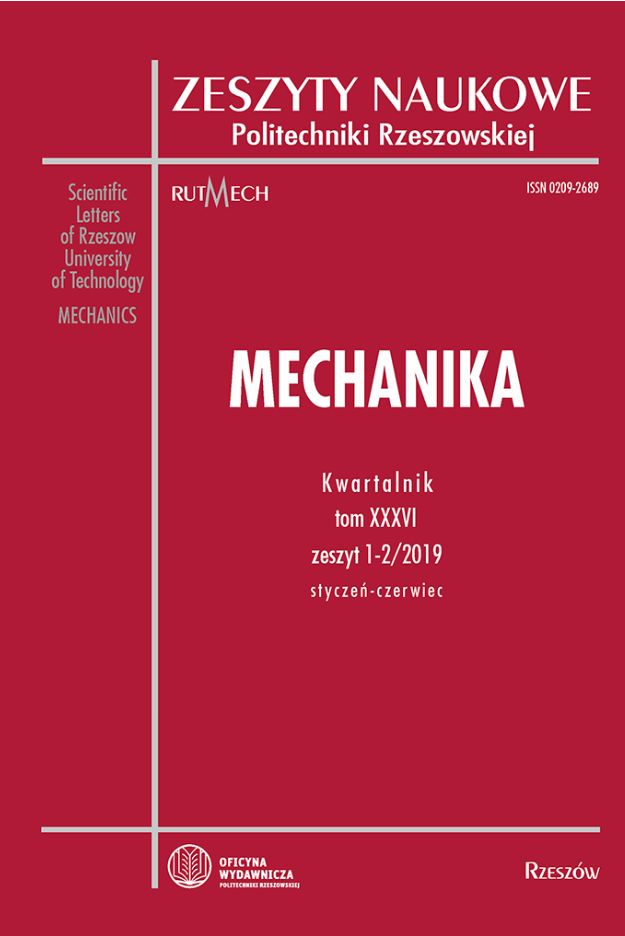Abstract
The drilling of ductile materials, such as Ti6Al4V, is often associated with insufficient chip evacuation, resulting in disturbances in the machining process. Chips formed during the drilling process of plastic materials are ductile and tend to accumulate in the chip flutes of the tool. Such chip formation may result in scratches on the hole surface, sticking the material to the cutting tool, and also on accelerated wear of the cutting edge. This article presents the analysis of the drilling process and assessment of the quality of the hole after drilling Ti6Al4V titanium alloy without coolant at various processing parameters. As part of the research, the feed force and cutting moment were monitored, the shape and dimensional accuracy and the quality of the hole surface and the shape of the chips. The test results show that the hole quality can be improved by appropriate selection of cutting parameters. Observation of the surface at the exit of the tool from the material indicated plastic deformation (burrs) in different cutting conditions. The results of the experiment also showed that the shape and size of burrs is strongly influenced by the feed speed.
References
Ren N., Jiang L., Liu D., Lv L., Wang Q.: Comparison of the simulation and experimental of hole characteristics during nanosecond-pulsed laser drilling of thin titanium sheets, Int. J. Adv. Manuf. Technol., 76 (2014) 735-743.
Shetty P.K., Shetty R., Shetty D., Rehaman N.F., Jose T.K.: Machinability study on dry drilling of titanium alloy Ti-6Al-4V using L9 orthoganal array, Procedia Mater. Sci., 5 (2014) 2605-2614.
Shyha I.S., Soo S.L., Aspinwall D.K., Bradley S., Perry R., Harden P., Dawson S.: Hole quality assessment following drilling of metallic-composite stacks, Int. J. Tools Manuf., 51 (2011) 569-578.
Abdelhafeez A.M., Soo S.L., Aspinwall D.K., Dowson A, Arnold D.: Burr formation and hole quality when drilling titanium and aluminium alloys, Procedia CIRP, 37 (2015) 230-235.
Bi S., Liang J.: Experimental studies and optimization of process parameters for burrs in dry drilling of stacked metal materials. Int J. Adv. Manuf. Technol., 53 (2010) 867-876.
Nouari M., List G., Girot F., Géhin D.: Effect of machining parameters and coating on wear mechanisms in dry drilling of aluminium alloys, Int. J. Tools Manuf., 45 (2005) 1436-1442.
Cantero J.L., Tardío M.M., Canteli J.A., Marcos M., Miguélez M.H.: Dry drilling of alloy Ti–6Al–4V, Int. J. Tools Manuf., 45 (2005) 1246-1255.
Li R., Hegde P., Shih A.J.: High-throughput drilling of titanium alloys. Int. J. Tools Manuf., 47 (2007) 63-74.
Dornfeld D.A., Kim J.S., Dechow H, Hewson J, Chen L.J.: Drilling burr formation in titanium alloy Ti-6AI-4V, CIRP Ann-Manuf. Technol., 48 (1999) 73-76.
Sun J., Guo Y.B.: A new multi-view approach to characterize 3D chip morphology and properties in end milling titanium Ti–6Al–4V, Int. J. Tools Manuf., 48 (2008) 1486-1494.
Pawar O.A., Gaikhe Y.S., Tewari A., Sundaram R., Joshi S.S.: Analysis of hole quality in drilling GLARE fiber metal laminates, Compos. Struct., 123 (2015) 350-365.
Bono M., Ni J.: The effects of thermal distortions on the diameter and cylindricity of dry drilled holes. Int. J. Tools Manuf., 41 (2001) 2261-2270.
Prasanna J., Karunamoorthy L., Venkat Raman M., Prashanth S., Raj Chordia D.: Optimization of process parameters of small hole dry drilling in Ti–6Al–4V using Taguchi and grey relational analysis, Measurement, 48 (2014) 346-354.
Hsu I., Tsao C.C.: Study on the effect of frequency tracing in ultrasonic-assisted drilling of titanium alloy, Int. J. Adv. Manuf. Technol., 43 (2008) 127-135.
Ko S., Chang J., Yang G.: Burr minimizing scheme in drilling, J. Mater. Process Technol., 140 (2003) 237-242.
Ko S., Lee J.: Analysis of burr formation in drilling with a new-concept drill,
J. Mater. Process. Technol., 113 (2001) 392-398.
Lei S., Liu W.J.: High-speed machining of titanium alloys using the driven rotary tool, Int. J. Tools Manuf., 42 (2002) 653-661.
Denkena B., Boehnke D., Dege J.H.: Helical milling of CFRP-titanium layer compounds, CIRP J. Manuf. Sci. Technol., 1 (2008) 64-69.


